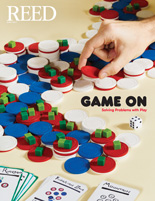
IRIS login | Reed College home Volume 96, No. 2: June 2017
Restoring a masterpiece, solving a mystery
The New York Times ran a fascinating story this week about the restoration of a landmark painting by Jackson Pollock, One: Number 31, 1950. The piece explains how conservators at the Museum of Modern Art, led by Jim Coddington ’74, restored the giant canvas that the Times characterized as a “masterpiece of Astract Expressionism.”
As they began the painstaking work of removing decades of grime from the painting, Coddington and his colleagues made a shocking discovery: some areas of the canvas were marked by synthetic resin, a kind of paint that Pollock had not been known to use. Furthermore, the resin had been applied using a sort of brushstroke that was unlike Pollock’s style. As Coddington told the Times, the sections showed a “fussiness that has nothing to do with the way Pollock applied paint.”
The evidence strongly suggested that these portions of the canvas had been painted over by someone else, possibly in an attempt to cover up some small cracks. But how could he be sure?
The answer lay in a photograph taken by Charles Rhyne [art history 1960–97] back in 1962, which showed plainly that the questionable sections had been added later—presumably by someone else, since Pollock died in 1956.
![Prof. Charles Rhyne [art history 1960-97]](../../assets/images/2013/04/rhyne.gif)
Professor Charles Rhyne provided the key to the puzzle.
Rhyne, who died of a stroke in April, was internationally renowned for his expertise in conservation, and influenced generations of art historians, including Coddington. “Charles’ curiosity was boundless,” Coddington wrote in a tribute to his former professor. “For more than four decades a conversation with Charles always left me with not only a clearer understanding of whatever the topic was but also introduced to new ones to think through. And they always left me hungry for more.”
Once he was certain the questionable sections did not reflect Pollock’s intentions, Coddington and his colleagues removed them, revealing fresh details beneath that had been previously obscured. The Times notes that they were careful to preserve many of the painting's quirks, including a fly that was entombed in the paint in the right-hand corner.
In his essay in Thinking Reed (a collection of essays by Reed grads), Coddington describes the dilemma that dogs every serious restoration:
Here is the very heart of the matter for a conservator: at no time is a picture more exposed, more likely to absorb its surroundings, than when it is being restored. The conservator brings his or her knowledge, judgment, and sensibilities to bear on the eventual look of the work. The intellectual apparatus and the course work and training, coupled with the experience of the craft of restoration, move one from the realm of theory to real practice, undeniably altering the very facts of the history of art and yet, somewhat paradoxically, seeking to return the work to an earlier state when the work was first created. These disciplines—art, art history, and science—formulate the questions and then suggest the answers that become the basis for all restoration decisions.
The painting is now on display at MOMA, a testament not only to Pollock's vision, but also to the meticulous scholarship of conservators such as James Coddington and his mentor, Charles Rhyne.
Tags: art, abstract expressionism


LATEST COMMENTS
steve-jobs-1976 I knew Steve Jobs when he was on the second floor of Quincy. (Fall...
Utnapishtim - 2 weeks ago
Prof. Mason Drukman [political science 1964–70] This is gold, pure gold. God bless, Prof. Drukman.
puredog - 1 month ago
virginia-davis-1965 Such a good friend & compatriot in the day of Satyricon...
czarchasm - 4 months ago
John Peara Baba 1990 John died of a broken heart from losing his mom and then his...
kodachrome - 7 months ago
Carol Sawyer 1962 Who wrote this obit? I'm writing something about Carol Sawyer...
MsLaurie Pepper - 8 months ago
William W. Wissman MAT 1969 ...and THREE sisters. Sabra, the oldest, Mary, the middle, and...
riclf - 10 months ago